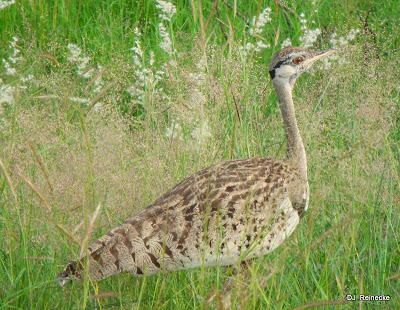Translate
Friday, 27 December 2013
760 Wattled Starling
This photo were taken at Krugersdorp Nature Reserve in the aviary there. The bird were testing some meat that were put out.The bird on the photo is a male in breeding. The female do not have the wattles.
769 Redwinged Starling
The red brown wing is diagnostic. The male is the one with the dark head and the female is the one with the grey head.
764 Glossy Starling
The Glossy Starling you find in Kruger National Park specifically at Tshokwane Picnic area but elsewhere as well. The colour is a metallic blue green. It do not occur in winter rainfall areas
761 Plum Coloured Starling
The female looks different(Lots of spots on her chest) .The photo is of a male.It were photographed in Kruger National Park
Thursday, 26 December 2013
104 Yellowbilled Duck
The diagnostic yellow bill is explaining the name. The patch on the wing is also a giveaway for identification.
66 Great White Egret
The photo were taken at Nylsvley which is a wetland in the Limpopo province. The bird were on the road and were giving this display. The bird were much bigger that the other egrets and the conclusion of the identification were that it is the Great White Egret.
If you are able to go to Nylsvley it is recommended.
520 Whitethroated Swallow
The diagnostic brown patch on the forehead is for me the indicator of the name. The name is based on the white throat on the bottom part of the bird.
Weaver building a nest
Weavers are building their nests mostly over water or a similar area to prevent snakes to raid their nests.
The male build the nest and the female accept it or reject it before laying eggs in it.
Hamerkop Nest
You will not be able to see it but when the photo were taken there were a Egyptian Goose nest on top of the Hamerkop nest. Other birds use the nest to built their own nests on top of it.
It is one of the biggest nests a bird (Hamerkop) is using.
Wednesday, 25 December 2013
Hamerkop
The name Hamerkop is derived from the tuft of feathers on his head. In this photo it is not visible due to the bird that flattened the feathers at the moment of the photograph
Lapwing Eggs
The eggs are difficult to find and it is just a hollow in the ground. When you approach a nest the parent birds will "attack " you or try to lure you away from the nest.
213 Black Crake
The bird is walking on the leaves of the water plant due to the weight distribution of the body on the exceptional long feet that helps with the weight distribution. The Jacana is also doing that.
Crested Guineafowl
The bird is not easy to find due to the area they live in. This photo were taken in northern KZN where they do occur. The other area is in the northern part of Limpopo.
Helmeted Guineafowl
A very common bird that is well known. You often find them next to roads as they look for grain that fell off grain trucks.
They are turning the soil and in that way mix the soil particles with dead grass and help with soil aeration.
The name is derived from the helmet look alike on the head.
When they are kept in captivity they tend to develop white feathers due to elements in their diet that is only available in nature itself.
Black Korhaan
This bird is one that flies up and the sound in Afrikaans is "Ja wragtig Ja wragtag" meaning that you are bothering him.
This one were captured on film at Rietvlei Nature Reserve just outside Pretoria.
Water Dikkop
The way to recognise them is to look for the "line" running paralel on the wing and they are smaller than the veld Dikkop.
Jacana
As you can see is that the Jacana can easily walk on the leaves of the lily plants. The hunt is on for insects.
Goliath Heron
The Goliath Heron is the largest Heron. The name is obvious due to it's large size. There is a breeding pair at Lake Panic in Kruger park where this photo were taken.
The catch fish for a meal by walking in ponds or next to a river.
Redbilled Oxpecker
Oxpeckers comb the hair of animals to get the mytes of the animal and feed in this process.
The use of chemicals were harmful to them and they became extinct in certain areas where cattle were dipped. The chemical companies developed oxpecker friendly dips and the birss is slowly coming back.
The other day a farmer complained that the oxpeckers are bloodthirsty as they peck at a calf untill they draw blood and then they carry on an on.
Crested Barbet
This barbet is a colorful one and that is the difference between the black collared barbet and this one. The sounds that they make differ as well.
Southern Ant Eating Chat
The Afrikaanse naam is Swart Piek. The bird is found on grassland and in this instance at Rietvlei Nature Reserve. They are usually next to the road.
Tuesday, 24 December 2013
Bergklipwagter
The photo were taken at Marakele National Park where this bird is a resident on the mountain at the microwave towers.
Jackal Buzzard
Birders like to talk on the diagnostic features of a bird. In the case of the Jackal Buzzard the brown in front is diagnostic of this bird.
Subscribe to:
Comments (Atom)

















































